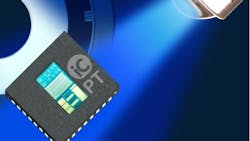iC-Haus (Bodenheim, Germany) has developed sensor chips for optical position encoders that use photodiodes designed especially for light from blue LEDs. Ordinarily, optical encoders are designed for use with light from red or infrared LEDs.
The company says that the shorter wavelength and penetration of blue-light photons improve the resolution, signal amplitude, harmonic distortion, and jitter performance of incremental and absolute encoders. Blue light causes less diffraction at the same slot width compared to red or IR light, thus resulting in sharper imaging.
Modern semiconductor processes can produce small, shallow structures that can take advantage of the shorter penetration of blue light to improve efficiency. In addition, the smaller structures allow an interlaced photodiode layout that produces sine and cosine encoder signals with lower offset. A high fill factor for the photosensitive areas is achieved by an equivalent geometrical transformation, says iC-Haus, which notes that the integration platform for such single chip encoders is denoted by the trademark "Encoder blue."
The encoder chips of the iC-PT H-Series combine scanning and signal interpolation in a flat 5 x 5 mm² optoQFN package with a plane window. A scanning area of 1.9 x 3.1 mm is sufficient to generate 10,000 pulses per revolution using a code disc of 26 mm diameter (in one example).
The devices generate low-jitter encoder quadrature signals with index in single, double, and fourfold resolution. Output frequencies of up to 1.6 MHz are permitted, enabling motor speed control at up to 10,000 rpm with 10,000 pulses per revolution.
For more information, see http://www.ichaus.com/encoder-blue

